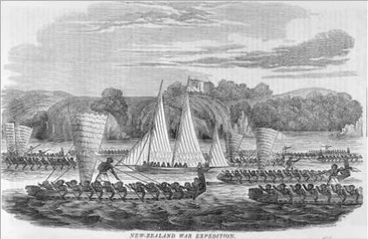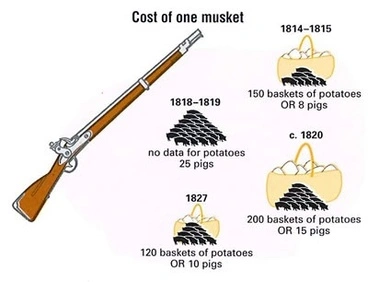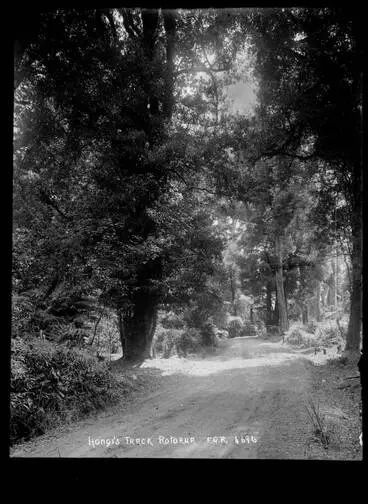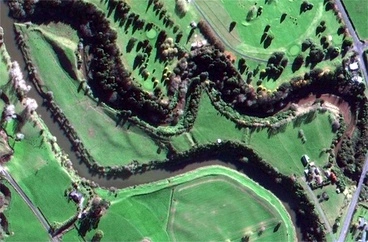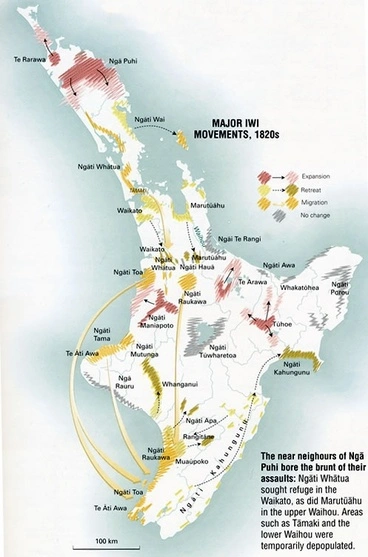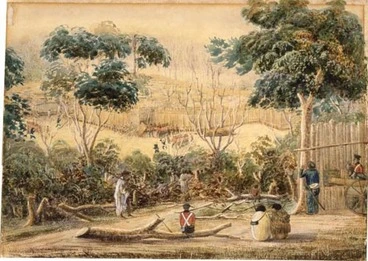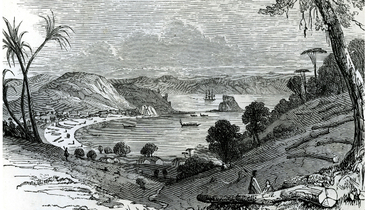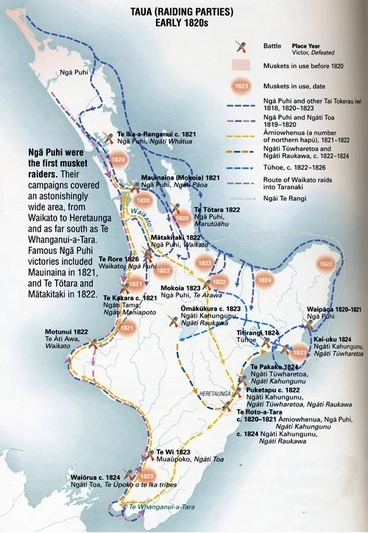The Musket Wars 1818 - 1830s
A DigitalNZ Story by National Library of New Zealand Topics
Prior to the New Zealand Wars | Ngā Pakanga o Aotearoa, the Musket Wars were a series of inter-tribal Māori conflicts dominated by utu and muskets. It occurred over three decades in the early 19th Century. SCIS no. 1965852
social_sciences, arts, english, history, health, Māori, technology
Ngāpuhi war expedition, 1820s
Manatū Taonga, the Ministry for Culture and Heritage
Musket costs
Manatū Taonga, the Ministry for Culture and Heritage
Haka with muskets
Manatū Taonga, the Ministry for Culture and Heritage
Overview - Musket Wars
Manatū Taonga, the Ministry for Culture and Heritage
Flintlock musket
Museum of New Zealand Te Papa Tongarewa
musket ball
Auckland War Memorial Museum Tāmaki Paenga Hira
Maori man holding a musket
Museum of New Zealand Te Papa Tongarewa
Maori man with a musket
Museum of New Zealand Te Papa Tongarewa
Warrior chief: the story of Hongi Hika
Radio New Zealand
Your Place - Lepperton
Radio New Zealand
Missionaries and muskets at Kerikeri - roadside stories
Manatū Taonga, the Ministry for Culture and Heritage
Changing cost of muskets 1814-1827
Manatū Taonga, the Ministry for Culture and Heritage
Showing Hongi's Track which was a canoe portage between Lake Rotoiti and Lake Rotoehu, north east of Rotorua. It was used by Hongi Hika (Ngāpuhi) in 1823 to attack the Arawa people living on Mokoia Island during the Musket Wars.
Hongi's Track, Rotorua
Auckland Libraries
Shows a large Ngāpuhi waka taua returning from Musket War battles (Bay of Plenty and East Cape) early in 1819.
Alexander Turnbull Library
Mātakitaki Pā
Manatū Taonga, the Ministry for Culture and Heritage
Portrait of Ngāpuhi chiefs Waikato (left), Hongi Hika and missionary Thomas Kendall (right).
Manatū Taonga, the Ministry for Culture and Heritage
During Ngāpuhi’s part in the Musket Wars Hongi Hika wore armour, (chain mail) which successfully deflected musket fire in battle.
Armour from Auckland War Memorial Museum
Manatū Taonga, the Ministry for Culture and Heritage
A war raid dated from the Musket Wars carried out by Ngāpuhi. This taua (war party) was on its way to Tauranga in 1833.
Williams, Henry, 1782-1867 :New Zealand war expedition. [Engraving. London, Seely's, 1835 & 1849]
Alexander Turnbull Library
This musket belonged to Hongi Hika, the renowned Ngāpuhi war leader, who is one of the pivotal figures of the Musket Wars.
Hongi Hika's musket
Manatū Taonga, the Ministry for Culture and Heritage
1820s iwi movements map
Manatū Taonga, the Ministry for Culture and Heritage
Plan of Kaiapoi pā
Manatū Taonga, the Ministry for Culture and Heritage
Nene, as a war leader, went with the expedition which travelled the length of the North Island in 1819 and 1820, plundering and taking captives in what became known as the Musket Wars.
Tamati Waka Nene
Auckland Art Gallery Toi o Tāmaki
An interesting relic from the Musket Wars
:A relic of great historic importance has just been presented to the Auckland Museum. It is an old Tower musket, and the following note is attached to the stock: —" This musket was given to Hongi Hika, afterwards known as 'The Maneater,' by George IV. of England, in the year 1820. It was used by him in the battles of Ikaranganui, Mokoia, and Marakitaki, and many other lesser engagements."
National Library of New Zealand
Flintock musket
Many of the guns used in the Musket Wars were trade muskets. These were inferior to standard-issue military muskets of the time. They were manufactured using a lower grade of Birmingham steel, prone to misfire (or worse they could explode) and were less accurate. However, they had some advantages, they were lighter, stones and scrap iron could be used as a substitute for musket-balls and as they didn’t require using a ramrod they were faster to reload. You simply banged the musket butt on the ground after first loading the powder then another tap after you load the shot. Another favourite weapon used by toa and the time (and with devastating effect in the New Zealand Wars ) was the tupara o
Auckland War Memorial Museum Tāmaki Paenga Hira
This South Island memorial marks one of the last battle raids of the Musket Wars
This memorial erected in 1937 marks one of the Musket Wars last raids. In 1836 Te Puoho o te Rangi (Ngati Tama) set out from Taitapu (Golden Bay) with a taua, aiming to launch a surprise attack on Ngai Tahu in Southland. This meant a long arduous journey down Waiponamu’s West Coast. At a distance of over 1000 kilometres, it represented an extraordinary feat of endurance but as a military success, it was a disaster. By January of the following year 1837, the war party had arrived in Southland. Though weakened by fatigue and hunger they captured several Nga Tahu eeling parties. After arriving at Tuturau Te Puoho’s party were subsequently surprised by Ngai Tahu toa. Te Puoho was killed by Top
Manatū Taonga, the Ministry for Culture and Heritage
A haka with muskets
In some respects, the Musket Wars was New Zealand’s very own arms race. An iwi without muskets (as happened in the initial phases of the inter-tribal conflict) was completely defenceless and very likely to be annihilated or enslaved. It didn’t matter how proficient you were physically with rakau Māori - traditional stone or wooden weapons as they offered no defence to against musket fire. So, Iwi economies rapidly constructed themselves around European trade contacts and traded items like fish, harakeke, timber, potatoes, pigs, mokomokai and sometimes Māori women to purchase guns. Ironically initial trade of muskets to Māori was made not only by whalers and British naval vessels but also
Alexander Turnbull Library
Utu
Utu was a kai that sustained the Musket Wars. With muskets and a constant supply of potatoes iwi could initially mount successful campaigns and raids obstinately to seek utu for acts of outrage, and revenge against themselves, relatives or related hapu or iwi. Insults could also initiate utu. A notable Musket War example was Te Rauparaha’s attack on Nga Tahu’s Omihi pa. The attack was to seek utu as the rangitira of the pa, Rerewaka, had cursed Te Rauparaha by proclaiming he would rip open his belly with a barrracuda or shark’s tooth. The pa was sacked, and Nga Tahu defenders slaughtered or enslaved. Rerewaka was captured and suffered the agonising fate of his curse!
Alexander Turnbull Library
Potato crops
The Musket Wars has also been referred to by some historians as the Potato Wars. The potato offered Māori numerous advantages during this period of inter-tribal conflict. Easy to grow and sell potatoes did not require men to cultivate it, unlike the kumara. Instead the crop could be tended by slaves (captured during raids) which in turn released men to join taua. Potatoes were also a very tradable commodity especially with Europeans who visited Aotearoa at this time. The increasing need for labour to cultivate potatoes to trade for muskets became an almost cyclical process of violence. To acquire more slaves to cultivate crops in order to buy more muskets you needed to mount more raids.
Alexander Turnbull Library
The Musket Wars was a period of ferocious Māori versus Māori conflict which spread across much of the country during the early decades of the 19th century.
Māori warfare
Services to Schools
Tāmati Waka Nene
Services to Schools
The Musket Wars in the Wai Pounamu South Island
Services to Schools
Te Puoho was a prominent Ngāti Tama leader during the Musket Wars
Services to Schools
Ngāi Tahu and wars with Ngāti Toa
Services to Schools
Te Puoho’s raid on Ngāi Tahu was one of the last in the Musket Wars
Services to Schools
Alien Weaponry - Kai Tangata
Services to Schools
The coming of the musket
Services to Schools
Te Amotu Takanawa
Services to Schools
Te Āti Awa of Wellington
Services to Schools
The Battle of the Shark’s Tooth
Services to Schools
Musket wars
Services to Schools
Pomare I, Nga Puhi warrior, and leader
Services to Schools
War, migration and change
Services to Schools
Fall of Te Totara pa, 1821
Services to Schools
Classroom ideas - the Musket Wars
Services to Schools
A Māori military engineering feat
Services to Schools
Sale of muskets a hit at Kerikeri Mission
Services to Schools
Pigs and potatoes
Services to Schools
Wiremu Kingi Moki Te Matakatea
Services to Schools
Tuturau Māori reserve and war memorial
Services to Schools
Book Review - Guns and Utu
Services to Schools
Brown Bess muskets
Services to Schools
Early encounters - guns, missionaries and trade change Aotearoa
Services to Schools
Slavery and Māori
Services to Schools
How Aokapurangi saved her people
Services to Schools
Māori and muskets from a pan-Polynesian perspective
Services to Schools
Opening up all the old wounds
Services to Schools
Preserved Māori head returns to New Zealand
Services to Schools
The trade in preserved Māori heads
Services to Schools
Warrior chief: the story of Hongi Hika
Services to Schools
Te Wherowhero - Part 8: Te Karaka
Services to Schools
Te Rauparaha Part 1: Kawhia and the journey south
Services to Schools
Hongi’s Track
Services to Schools
Hongi Hika and early Pakeha history
Services to Schools
Te Kai a te Karoro, the Seagull's Feast
Services to Schools
Loading and firing the flintlock musket
Services to Schools
Te Mana Whatu Ahuru: Report on Te Rohe Pōtae Claims
Services to Schools
A Maori military feat
Services to Schools
The coming of the musket
Services to Schools
A teki was used to make cartridges for a musket.
Teki (cartridge making stick)
Museum of New Zealand Te Papa Tongarewa
Pakeha and Te Āti Awa people defend themselves against attacking Waikato Māori during the Musket Wars.
Manatū Taonga, the Ministry for Culture and Heritage
A waiata about musket warfare
Manatū Taonga, the Ministry for Culture and Heritage
Pukerangiora
Manatū Taonga, the Ministry for Culture and Heritage
The Musket Wars
Services to Schools
A war speech made during the Musket Wars
Manatū Taonga, the Ministry for Culture and Heritage
Growing potatoes
Manatū Taonga, the Ministry for Culture and Heritage
The Northern War 1845-46
DigitalNZ
